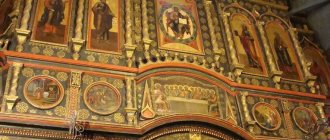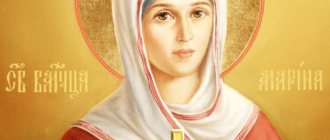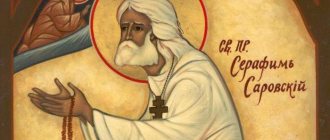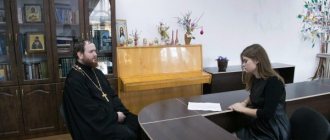Story
encolpion or encolpion,
used in the ancient Christian church, as well as in ancient Russia.
(from the Greek έν κολπειώ - behind the bosom, on the chest). Encolpions first had the shape of a four-sided box, empty inside; on the outside of them there was an image of a monogram of the name of Jesus Christ, and later - a cross of various shapes. In this box, particles of relics were kept, and in the era of persecution - lists of sacred Christian books. Two specimens of encolpium, which, according to archaeologists, date back to no later than the 4th century, were found in 1571 during the excavation of one of the Vatican graves.
John Chrysostom (347 - 407) testifies to the existence of encolpii in the 4th century in the word “Against the Jews and Gentiles that Jesus Christ is the true God”: “Why to this very tree on which the holy body of Jesus was spread out and nailed , everyone is rushing in? Why do many, both husbands and wives, having received a small piece of this tree and overlaid it with gold, hang it on their necks as an ornament?
, whereas it was once a sign of condemnation and punishment? Because He who created everything and transformed everything, who delivered the universe from wickedness and made the earth heaven, He exalted this hateful and shameful instrument of all deaths above the heavens.” (The highlighted words are often cited as a quotation from the word “Against the Anomeans,” thereby proving that this custom is somehow connected with Arianism, but the source of such a quotation is difficult to establish).
Later they take the shape of a cross, still retaining emptiness inside, for storing sacred relics. In this form, they became part of the episcopal rank and were worn by bishops over their clothes. The oldest example of such an encolpium was found in 1862 in the ruins of the Basilica of St. Lawrence built by Constantine the Great in Rome, on the chest of a skeleton buried in the church - probably a bishop. Encolpia crosses were also part of the royal ceremonial vestments in Constantinople, and later in Russia, before Peter the Great. In ancient Rus', they were sometimes worn (under their clothes) by simple monastics and even by pious laypeople, such as pilgrims. In church and archaeological collections, for example in the museum of the St. Petersburg Theological Academy, there are encolps of remarkable size and design.
In the 18th century, encolpias with boxes inside fell out of use and were replaced for bishops by smaller crosses made of metal or enamel, without emptiness or attachments inside. In Russia, since 1741, the wearing of such crosses was adopted by archimandrites who were members of the Synod, and since 1742, following the example of the monasteries of the Kiev diocese (where pectoral crosses have long been worn by all archimandrites) - by all archimandrites, unlike abbots, which remains the same. present time.
Is it true that gold is the devil's metal?
There is an opinion among most people that gold is the metal of the devil. It is based on the sayings of medieval philosophers and theologians who condemned money-grubbing and self-interest . So, according to the Gospel of Mark, the publican (tax collector) Matthew threw gold coins into the dust and followed Christ, becoming his apostle. One can also recall the Old Testament golden calf, which was worshiped by the Jews, destroyed by the prophet Moses.
But at the same time, in Christianity, gold in itself does not symbolize something bad, devilish . Since this religion in its essence is not material, but spiritual, the focus of sin in it is human thoughts and actions . Inanimate objects in the Christian faith have a purely symbolic meaning and are not independent “actors.”
Therefore, religion, while condemning the unbridled desire in people to possess gold, does not at all consider the metal itself to be a container or embodiment of the devil. In Orthodoxy, gold is associated with the brilliant glory of Christ, the dazzling purity of the sky, where the Lord dwells . The Bible also mentions that the wise men brought, among other things, gold as a gift to the baby Jesus. The theologian John, Archbishop of Constantinople, was nicknamed “Chrysostom” for his magnificent sermons.
A little about the energy of gold
The issue of gold energy has long been the subject of fierce debate. Some believed that this yellow metal acquired mystical power over its owner, making him greedy and unprincipled . As an example, numerous cases were cited when the thirst for gold became the cause of the most terrible crimes, in which even close relatives were drawn into.
At the same time, gold was endowed with noble properties . Thus, in the ancient world it was believed that it was capable of neutralizing poisons . Gold was also used for medicinal purposes: against cardiovascular diseases, colds and epilepsy. Taoist monks approached the question of the energetic influence of gold on a person, his body, psyche and moral qualities purely dialectically: it affects some well, others badly.
According to ancient Chinese philosophy, the power of gold rejuvenates the body, makes a person’s character more cheerful and kind. But this only applies to people who are predisposed to positivity. For people with low spiritual development, prone to anger and laziness, this metal has the opposite effect. It awakens in their soul the worst, basest manifestations of nature. Gold is considered a conductor of solar energy among many peoples . Even the ancient Egyptians, American Incas, Aztecs and Mayans called this metal solar, believing that the sun itself also consists of gold.
In the Russian Orthodox Church
Until the 18th century, in the Russian Church only bishops had the right to wear pectoral crosses. In 1742, Empress Elizaveta Petrovna drew the attention of the Holy Governing Synod to the fact that all Little Russian archimandrites wore pectoral crosses, unlike Great Russian ones, who did not have such a right. On December 9, 1742, the Holy Synod sent decrees to all dioceses to place pectoral crosses on all archimandrites, to distinguish them from abbots. Empresses Elizabeth and Catherine the Great complained about pectoral crosses to their confessors[1].
In 1797, Emperor Paul established, as a badge of honor, and issued to archpriests and priests, a four-pointed pectoral cross, silver gilded, with the image of the Crucifixion. It was the fourth award in order (after the nabedrennik, skufya and kamilavka).
Since 1820, the same cross, but all gold, with a cast Crucifix and an image of the imperial crown on the inside, was complained from His Majesty’s Cabinet to the court priests, as well as to priests of Orthodox churches abroad when they entered the service, and was left to them forever if they served under those churches for at least seven years.
Archpriests and priests who already had one of the two above-mentioned pectoral crosses were allowed to accept and wear pectoral crosses with precious decorations presented to them by parishioners. Priests who had the academic degrees of candidate, master and doctor were given special crosses, of which the doctor's cross was a pectoral cross, and the master's and candidate's crosses were worn in a buttonhole fastened to the collar of the cassock. The doctoral and master's crosses were established in 1808, the candidate's cross in 1884. Pectoral crosses made of brown bronze on a Vladimir ribbon were established for distribution to all priests at the end of the wars of 1812-1814 and 1853-1855.
In 1896 (on the occasion of the coronation), Emperor Nicholas II established a new type of pectoral cross; The decree states: “according to the definition of the Holy Synod <...> all serving priests of the monastic and white clergy, as well as those newly ordained to the said rank <are given> the right to lay on themselves a cross” of the established pattern[2]. The cross had an eight-pointed shape, was made of silver, the Crucifixion was depicted on the front side, and the words “ wake the image with the right word, life, love, spirit, faith, purity”
"(1 Tim 4:12), as well as the monogram of Emperor Nicholas II and the date of his coronation in Church Slavonic (Church Slavonic numbers)[3]. Since then, the pectoral cross has been a customary accessory for a priest in Russia, unlike, for example, Greece, where ordinary priests do not wear a pectoral cross.
After 1896, all priests began to wear the St. Nicholas eight-pointed pectoral cross from the moment of ordination to the priesthood until they were awarded the four-pointed “Pavlovian” cross.
In the middle of the 20th century, the golden Patriarchal Pectoral Cross appeared - which is the highest sign of recognition of the merits of an archpriest or archimandrite. It is awarded in exceptional cases, for special church services, by the will and decree of the Patriarch of Moscow and All Rus', regardless of length of service and previous awards (see: list of those awarded the Patriarchal Pectoral Cross).
Currently, after their ordination, all priests are given a pectoral cross, which they wear during divine services over their vestments, and in everyday situations over their cassock. It has an eight-pointed shape. On the front side there is a relief image of the crucified Jesus Christ and the inscription in the upper part: “Where, TsR҃ь SL҃Вы” (“The Lord is the King of Glory”); at the ends of the wide crossbar “ІС҃ ХС҃” (“Jesus Christ”), under the lower oblique crossbar - “NIKA” (Greek - winner). On the back of the cross is the inscription: “Be an image with the right word, life, love, spirit, faith, purity.”
(1 Tim. 4:12).
Altar cross.
It is a necessary accessory of a Christian church. They are located on the altar throne next to the Gospel. Used during church services. They differ from pectoral and icon crosses in their larger sizes - from 30 cm and above.
The price for altar crosses, as well as for icon cases, varies greatly from 6000 to infinity.
Now, regarding whether to raise crosses or not, in general, a cross is a cultural and religious object and the fact that it is lying in the ground is of course not correct, but as for ancient crosses, in some cases they also have historical value. Another thing is that the choice of what to do with it—sell it or take it to church—will be up to you, but when you go into a church and see an obviously used cross on the counter, for which they are asking for some kind of donation, they question the delivery of the cross to the church.
In the Catholic Church
History of application
In the first centuries of Christianity, adults usually did not wear a cross. They wore medallions with images of the slain Lamb or the Crucifixion. But already St. John Chrysostom (late 4th century AD), condemning foolish women who placed amulets on infants enlightened by Holy Baptism, exclaimed: “Nothing should be placed on infants except the saving cross.” It is known that St. Gregory the Great sent Theodelinda, queen of the Lombards, two flat medallions with the image of the Crucifixion on them to wear on her chest. He sent crosses to others to wear. Only in the acts of the 7th Ecumenical Council (act 4) it is said that the martyr Procopius (d. 303), who suffered under Diocletian, wore a cross around his neck, half gold, half silver. The same is known about the Christian warrior martyr Orestes (d. 304).
Crosses were worn both on the body (under clothing) and on top of clothing, and in the second case, the cross symbolizes the type of service performed by a person (bishop, priest). One of the earliest mentions of the pectoral cross is its mention by Pope Gilarius in 461. In 811, the Byzantine Emperor Nikephoros I sent Pope Leo III a golden pectoral cross.
However, until the 14th century, the pectoral cross did not become widespread in the Western Church. The use of the pectoral cross in the Roman rite became necessary for the first time in the Roman Pontifical of Pius V.
The first Anglican bishop to wear the pectoral cross was Edward King, Bishop of Lincoln (1885–1910).
| This section of the article has not been written. According to the plan of one of the Wikipedia participants, a special section should be located in this place. You can help by writing this section. |
Is the price of the cross as a tribute to God or as contempt for cheap wood?
In church tradition, crosses are not called “gold” or “silver”, but rather yellow and white . Moreover, they are not made from these precious metals at all . The yellow crosses of ordinary priests are made of brass, and they cost at most 10 thousand rubles, of which the main cost is the work of the master maker. White crosses are made mainly from cupronickel, and their price is about 5 thousand rubles. At ceremonial services, brass and cupronickel crosses are polished by their owners to such an extent that it is almost impossible to distinguish them by their shine from works made of real precious metal from the outside.
And only the crosses of the highest church hierarchs, from the bishop and above, are made using gold . But, again, they are not cast from a single piece of precious metal, but use sputtering and gilding technology. Real gold on such a cross will accumulate at most 2-3 grams .
According to the internal church charter, each clergyman is obliged to appear at official receptions with the highest clergy with his own cross, indicating his status.
And finally, it should be noted that crosses, even brass and cupronickel, are not the personal property of the priest, but are issued to him for the duration of his service, so to speak, “on account . When removing the priesthood, the clergyman returns to the bishop the cross that was once given to him.
Fashionable jacket for fall 2019
Is there a student in the family? It's time to take a closer look at the preppy style
Pectoral cross
The cross given to every Orthodox Christian at baptism; usually worn directly on the body, which is why it is called the body cross
, or
vest
;
It can be either metal or wood (cypress is especially common). The tradition of wearing a pectoral cross implies its symbolic meaning: readiness to follow the words of the Gospel: “If anyone wants to come after Me, let him deny himself, and take up his cross, and follow Me”
(Mark 8:34). This tradition is not universal, although in Russia it is universal among Orthodox Christians. In the Soviet Union, for many, wearing a cross was a form of confession; after the end of the persecution, it became fashionable for some time. Wearing a cross along with icons, belts and even rings with texts of prayers can be superstitious if the wearer perceives it as one of the possible amulets.
In the Russian Orthodox tradition, the inscription “ Save and preserve”
" The depiction of a crucifix on a body cross is a late tradition. Old Believers categorically reject such crosses, believing that images of a person liken a pectoral cross to an icon, the wearing of which is contrary to the rule of Basil the Great (see Nomocanon): “Anyone who wears any icon as an amulet must be excommunicated from communion for three years " But the Old Believers welcome the image, for example, of a vine on a woman’s cross as a reminder of the words of the psalmist: “Your wife is like a fruitful vine in the countries of your home” (Ps. 127:3).
Kyoto cross.
They differ from pectoral crosses in their larger size and do not have an eyelet for a neck cord. They were placed on special shelves (cases) among the holy icons in the red corner, and attached to the doorposts of the home. They were used to crown home iconostases and take them with them on travels, hikes, and trips to create temporary altars.
The prices for icon crosses vary greatly from 1000 to 10000.
Excerpt characterizing the Pectoral Cross
“You know that this is my greatest pleasure,” Natasha said. “This is bad,” he rode himself, ordered him to saddle, but didn’t tell us anything. – All obstacles to the Russians are in vain, let’s go! – Petya shouted. “But you’re not allowed to: Mama said you’re not allowed to,” said Nikolai, turning to Natasha. “No, I’ll go, I’ll definitely go,” Natasha said decisively. “Danila, tell us to saddle up, and for Mikhail to ride out with my pack,” she turned to the hunter. And so it seemed indecent and difficult for Danila to be in the room, but to have anything to do with the young lady seemed impossible to him. He lowered his eyes and hurried out, as if it had nothing to do with him, trying not to accidentally harm the young lady. The old count, who had always kept a huge hunt, but now had transferred the entire hunt to the jurisdiction of his son, on this day, September 15th, having fun, got ready to leave too. An hour later the whole hunt was at the porch. Nikolai, with a stern and serious look, showing that there was no time to deal with trifles now, walked past Natasha and Petya, who were telling him something. He inspected all parts of the hunt, sent the pack and hunters ahead to the race, sat down on his red bottom and, whistling the dogs of his pack, set off through the threshing floor into the field leading to the Otradnensky order. The old count's horse, a game-colored mering called Bethlyanka, was led by the count's stirrup; he himself had to go straight in the droshky to the hole left for him. Of all the hounds, 54 dogs were bred, under which 6 people went out as handlers and catchers. In addition to the masters, there were 8 greyhound hunters, who were followed by more than 40 greyhounds, so that with the master's packs about 130 dogs and 20 horse hunters went out into the field. Each dog knew its owner and name. Each hunter knew his business, place and purpose. As soon as they left the fence, everyone, without noise or conversation, stretched out evenly and calmly along the road and field leading to the Otradnensky forest. The horses walked across the field as if walking on a fur carpet, occasionally splashing through puddles as they crossed the roads. The foggy sky continued to descend imperceptibly and evenly to the ground; the air was quiet, warm, soundless. Occasionally one could hear the whistling of a hunter, the snoring of a horse, the blow of an arapnik, or the yelp of a dog that was not moving in its place. Having ridden about a mile away, five more horsemen with dogs appeared from the fog to meet the Rostov hunt. A fresh, handsome old man with a large gray mustache rode ahead. “Hello, uncle,” Nikolai said when the old man drove up to him. “It’s a real march!... I knew it,” said the uncle (he was a distant relative, a poor neighbor of the Rostovs), “I knew that you couldn’t stand it, and it’s good that you’re going.” Pure march! (This was my uncle’s favorite saying.) - Take the order now, otherwise my Girchik reported that the Ilagins are standing in Korniki with pleasure; You have them - pure march! - they will take the brood under your nose. - That's where I'm going. What, to bring down the flocks? - Nikolai asked, - get out... The hounds were united into one pack, and uncle and Nikolai rode side by side. Natasha, wrapped in scarves, from under which a lively face with sparkling eyes could be seen, galloped up to them, accompanied by Petya and Mikhaila, the hunter who was not far behind her, and the guard who was assigned as her nanny. Petya laughed at something and beat and pulled his horse. Natasha deftly and confidently sat on her black Arab and with a faithful hand, without effort, reined him in. Uncle looked disapprovingly at Petya and Natasha. He did not like to combine self-indulgence with the serious business of hunting. - Hello, uncle, we're on our way! – Petya shouted. “Hello, hello, but don’t run over the dogs,” the uncle said sternly. - Nikolenka, what a lovely dog, Trunila! “he recognized me,” Natasha said about her favorite hound dog. “Trunila, first of all, is not a dog, but a survivor,” thought Nikolai and looked sternly at his sister, trying to make her feel the distance that should have separated them at that moment. Natasha understood this. “Don’t think, uncle, that we will interfere with anyone,” said Natasha. We will remain in our place and not move. “And a good thing, countess,” said the uncle. “Just don’t fall off your horse,” he added: “otherwise it’s pure marching!” - there’s nothing to hold on to. The island of the Otradnensky order was visible about a hundred yards away, and those arriving were approaching it. Rostov, having finally decided with his uncle where to throw the hounds from and showing Natasha a place where she could stand and where nothing could run, set off for a race over the ravine. “Well, nephew, you’re becoming like a seasoned man,” said the uncle: don’t bother ironing (etching). “As necessary,” answered Rostov. - Karai, fuit! - he shouted, responding with this call to his uncle’s words. Karai was an old and ugly, brown-haired male, famous for the fact that he single-handedly took on a seasoned wolf. Everyone took their places. The old count, knowing his son’s hunting ardor, hurried not to be late, and before those who arrived had time to drive up to the place, Ilya Andreich, cheerful, rosy, with trembling cheeks, rode up on his little black ones along the greenery to the hole left for him and, straightening his fur coat and putting on his hunting clothes, shells, climbed onto his smooth, well-fed, quiet and kind, gray-haired Bethlyanka like him. The horses and droshky were sent away. Count Ilya Andreich, although not a hunter by heart, but who firmly knew the hunting laws, rode into the edge of the bushes from which he was standing, took apart the reins, adjusted himself in the saddle and, feeling ready, looked back smiling. Next to him stood his valet, an ancient but overweight rider, Semyon Chekmar. Chekmar kept in his pack three dashing, but also fat, like the owner and the horse - wolfhounds. Two dogs, smart, old, lay down without packs. About a hundred paces further away in the edge of the forest stood another of the Count's stirrups, Mitka, a desperate rider and passionate hunter. The Count, according to his old habit, drank a silver glass of hunting casserole before the hunt, had a snack and washed it down with a half-bottle of his favorite Bordeaux. Ilya Andreich was a little flushed from the wine and the ride; his eyes, covered with moisture, shone especially, and he, wrapped in a fur coat, sitting on the saddle, had the appearance of a child who was going for a walk. Thin, with drawn-in cheeks, Chekmar, having settled down with his affairs, glanced at the master with whom he lived for 30 years in perfect harmony, and, understanding his pleasant mood, waited for a pleasant conversation. Another third person approached cautiously (apparently he had already learned) from behind the forest and stopped behind the count. The face was that of an old man with a gray beard, wearing a woman's hood and a high cap. It was the jester Nastasya Ivanovna. “Well, Nastasya Ivanovna,” the count said in a whisper, winking at him, “just trample the beast, Danilo will give you the task.” “I myself... have a mustache,” said Nastasya Ivanovna. - Shhh! – the count hissed and turned to Semyon. – Have you seen Natalya Ilyinichna? – he asked Semyon. - Where is she? “He and Pyotr Ilyich got up in the weeds from the Zharovs,” answered Semyon, smiling. - They are also ladies, but they have a great desire. - Are you surprised, Semyon, how she drives... huh? - said the count, if only the man was in time! - How not to be surprised? Boldly, deftly. -Where is Nikolasha? Is it above the Lyadovsky top? – the count kept asking in a whisper. - That's right, sir. They already know where to stand. They know how to drive so subtly that sometimes Danila and I are amazed,” said Semyon, knowing how to please the master. - It drives well, huh? And what about the horse, huh? - Paint a picture! Just the other day, a fox was snatched from the Zavarzinsky weeds. They began to jump over, out of delight, passion - the horse is a thousand rubles, but the rider has no price. Look for such a fine fellow! “Search...,” the count repeated, apparently regretting that Semyon’s speech ended so soon. - Search? - he said, turning away the flaps of his fur coat and taking out a snuff box. “The other day, as Mikhail Sidorich came out from mass in full regalia...” Semyon did not finish, hearing the rut clearly heard in the quiet air with the howling of no more than two or three hounds. He bowed his head, listened and silently threatened the master. “They’ve attacked the brood...” he whispered, and they led him straight to Lyadovskaya. The count, having forgotten to wipe the smile from his face, looked ahead along the lintel into the distance and, without sniffing, held the snuffbox in his hand. Following the barking of the dogs, a voice was heard from the wolf, sent into Danila’s bass horn; the pack joined the first three dogs and the voices of the hounds could be heard roaring loudly, with that special howl that served as a sign of the rutting of the wolf. Those arriving no longer squawked, but hooted, and from behind all the voices came Danila’s voice, sometimes bassy, sometimes piercingly thin. Danila’s voice seemed to fill the entire forest, came out from behind the forest and sounded far into the field. After listening in silence for a few seconds, the count and his stirrup became convinced that the hounds had split into two flocks: one large one, roaring especially hotly, began to move away, the other part of the flock rushed along the forest past the count, and in the presence of this flock Danila’s hooting could be heard. Both of these ruts merged, shimmered, but both moved away. Semyon sighed and bent down to straighten the bundle in which the young male was entangled; The count also sighed and, noticing the snuff-box in his hand, opened it and took out a pinch. "Back!" Semyon shouted at the dog, who stepped out beyond the edge. The Count shuddered and dropped his snuffbox. Nastasya Ivanovna got down and began to lift her. The Count and Semyon looked at him. Suddenly, as often happens, the sound of the rut instantly came closer, as if, right there in front of them, there were the barking mouths of dogs and the hooting of Danila. The count looked around and to the right he saw Mitka, who was looking at the count with rolling eyes and, raising his hat, pointed him forward, to the other side. - Take care! - he shouted in such a voice that it was clear that this word had been painfully asking him to come out for a long time. And he galloped, releasing the dogs, towards the count. The Count and Semyon jumped out of the edge of the forest and to their left they saw a wolf, which, softly waddling, quietly jumped up to their left to the very edge at which they were standing. The evil dogs squealed and, breaking away from the pack, rushed towards the wolf past the legs of the horses. The wolf stopped running, awkwardly, like a sick toad, turned his big forehead to the dogs, and also softly waddling, jumped once, twice and, shaking a log (tail), disappeared into the edge of the forest. At that same moment, from the opposite edge of the forest, with a roar similar to crying, one, another, a third hound jumped out in confusion, and the whole pack rushed across the field, through the very place where the wolf had crawled (ran) through. Following the hounds, the hazel bushes parted and Danila’s brown horse, blackened with sweat, appeared. On her long back, in a lump, lolling forward, sat Danila, without a hat, with gray, tousled hair over a red, sweaty face. “Whoop, whoop!” he shouted. When he saw the count, lightning flashed in his eyes. “F...” he shouted, threatening the count with his raised arapnik. -About...the wolf!...hunters! - And as if not deigning the embarrassed, frightened count with further conversation, he, with all the anger he had prepared for the count, hit the sunken wet sides of the brown gelding and rushed after the hounds. The Count, as if punished, stood looking around and trying with a smile to make Semyon regret his situation. But Semyon was no longer there: he, taking a detour through the bushes, jumped the wolf from the abatis. Greyhounds also jumped over the beast from both sides. But the wolf walked through the bushes and not a single hunter intercepted him.
Spread of crosses
In the 18th century, encolpions fell out of use almost everywhere. Instead, they began to use metal crosses without cavities inside. At the same time, the right to wear a pectoral cross was granted to bishops for the first time. Since the forties of the same century, this right in Russia has been vested in monastic priests with the rank of archimandrite, but only if they are members of the Holy Synod.
But a year later, namely in 1742, all archimandrites in general received the opportunity to wear a pectoral cross. This happened following the example of the Kyiv Metropolis, in which such a practice spread spontaneously even before its formal approval.
Establishing the right of white priests to wear crosses
White, that is, married clergy received the right to wear a pectoral cross at the end of the 18th century. Of course, not everyone was allowed to do this right away. At first, Emperor Paul introduced this attribute as one of the church awards for priests. It could be received for any merit. For example, a special example of the cross was given to many priests in 1814 in honor of the victory over the French army two years earlier. Since 1820, crosses were also given to those clergy who served abroad or at the imperial court. However, the right to wear this item could be deprived if the clergyman served in his position for less than seven years. In other cases, the pectoral cross remained with the priest forever.









